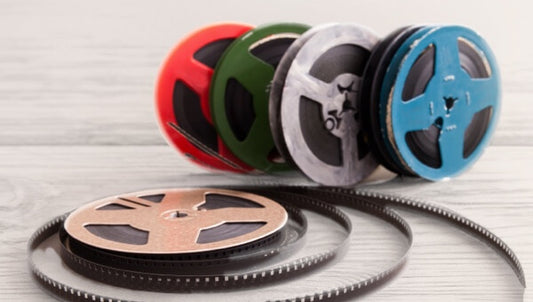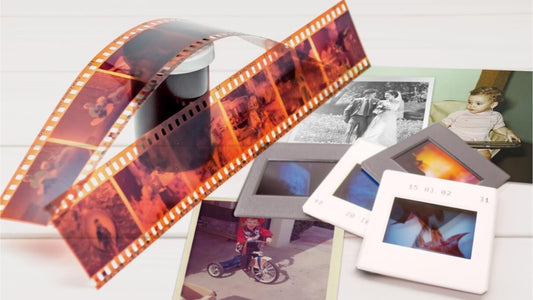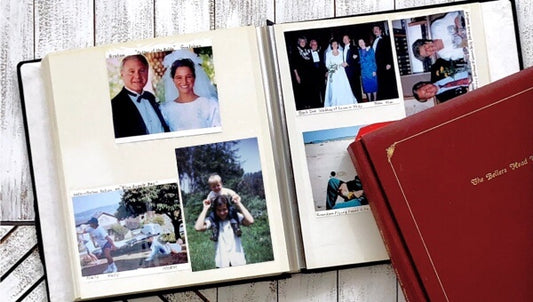Audio cassette tapes were the most popular way to listen to music on the go before the release of the CD. They could play music on a portable cassette player, in your car, or at home in a boombox - but how do cassette tapes actually work?
With over 20 years of preserving memories, Capture archival experts understand how important it is to also preserve analog formats and their history. We put together this guide to understand cassette technology and how it works.
Keep reading to learn about cassette tapes, how they record audio signals, the methods they use to play back the audio, and how to care for your cassette tapes and preserve them over time.
Jump to:
- When Were Cassette Tapes Invented and How Did They Work?
- What Are the Main Parts of a Cassette Tape?
- Recording on Cassette Tapes
- How Does a Cassette Tape Play Sound?
- Is a Cassette Tape Analog or Digital?
- How Long Do Cassette Tapes Last?
- What’s the Difference Between Ferric, Chrome, and Metal Cassette Tapes?
- Why Are Cassette Tapes Making a Comeback?
- Comparison with Other Audio Technologies
- Conclusion
When Were Cassette Tapes Invented and How Did They Work?
Cassette tapes use magnetic tape to store analog audio, a technology that became the standard for personal and portable listening for decades.

The compact cassette format introduced in the 1960s revolutionized home audio
Originally developed by the Philips company in 1962, cassette tapes used magnetic tape technology—also seen in formats like VHS and Betamax tapes. For cassettes, though, this storage method was used exclusively for audio.
The tape itself is a polyester film coated with ferric oxide particles, wound between two miniature spools. Inside the cassette shell are guide rollers, a pressure pad, and alignment notches that help the tape move evenly across the tape head during playback.
Before the compact cassette became the dominant standard in the 1980s, manufacturers experimented with different formats. In 1971, Advent Corporation introduced the Model 201 deck, which featured Dolby B noise reduction and chromium oxide tapes—paving the way for Hi-Fi cassette recording.
These innovations contributed to the popularity of cassette players like the Sony Walkman, and various tape types such as metal and chrome became common from the late 70s through the 90s. All of these developments laid the foundation for understanding how cassette tapes work.
What Are the Main Parts of a Cassette Tape?
To understand how cassette tapes work, it helps to know what they’re made of. Each part inside the cassette housing plays a role in recording, moving, or playing back sound.
Here’s a breakdown of the key components found inside a standard compact cassette:
- Magnetic Tape: A thin plastic strip coated with ferric oxide (or other magnetic materials) where audio data is stored.
- Supply Spool: Holds the unused tape and feeds it across the cassette mechanism.
- Take-Up Spool: Collects the tape as it’s played or recorded.
- Guide Rollers: Help guide the tape smoothly from one side to the other.
- Pressure Pad: A felt pad that presses the tape against the playback or recording head for contact.
- Shell/Casing: The plastic enclosure that holds all components together, usually with screws or rivets.
- Leader Tape: A non-magnetic strip at the beginning of the tape that prevents damage to recorded areas during loading.
Each part works together to move the tape consistently and ensure clean audio recording and playback. Even minor damage to any component—especially the magnetic tape or pressure pad—can cause distortion or loss of sound.
Recording on Cassette Tapes
Recording on a cassette tape involves converting audio signals into magnetic patterns that are embedded in the tape itself. This process requires a microphone or audio input, a recording head, and the magnetic tape.

The recording head uses electromagnetic force to imprint sound onto the magnetic tape
Here’s how the recording process works:
- Sound input: A microphone or line-in captures the audio and converts it into an electrical signal.
- Recording head: This small electromagnet alters the magnetic field on the tape to match the audio waveform.
- Moving tape: The magnetic tape passes over the recording head while the signal is imprinted in real time.
Once recorded, the tape can be played back repeatedly or erased and reused thanks to the built-in erase head. This feature made cassettes ideal for creating custom mixes or recording from the radio—similar to what users did with old VHS tapes.
Mixtapes became personal keepsakes and popular gifts for grandparents, partners, or friends. These homemade compilations were often decorated with popular 80s colors and handwritten labels.
How Does a Cassette Tape Play Sound?
Playing a cassette tape involves reading the magnetic data recorded on the tape and converting it back into audible sound. This process requires precise motion and alignment inside the cassette deck.

Playback occurs as the tape moves over a fixed head that reads the stored magnetic signal
Here’s how the playback mechanism works step by step:
- 1. Tape movement: A motor turns the capstan, pulling the tape at a consistent speed while a pinch roller holds it firmly in place.
- 2. Signal detection: The playback head reads the magnetic patterns stored on the tape’s surface.
- 3. Signal conversion: The tape deck converts these magnetic patterns into electrical signals and amplifies them.
- 4. Sound output: The amplified signal is played through headphones or speakers as audible audio.
If the tape doesn’t move at the correct speed, the sound can become distorted—resulting in effects like warble or pitch shifts. This is why keeping the playback mechanism clean and functional is crucial for consistent performance.
Additionally, cassette players allow users to pause, fast-forward, and rewind—a level of control that wasn’t possible with earlier formats like vinyl records or 8-tracks. This versatility made them popular for portable and car audio.
Is a Cassette Tape Analog or Digital?
Cassette tapes are a purely analog format. Instead of storing data as digital binary code, they preserve audio in the form of continuous magnetic patterns that mirror the original sound waves.
This analog method means cassette tapes can capture the full waveform of sound, but it also makes them more prone to hiss, distortion, and degradation over time compared to digital formats like CDs or MP3s.
Here’s a simple comparison:
| Feature | Analog (Cassette) | Digital (CD/MP3) |
|---|---|---|
| Signal Type | Continuous waveform | Binary data (0s and 1s) |
| Storage Medium | Magnetic tape | Optical disc or file |
| Sound Quality | Warm but less precise | Crisp and consistent |
| Editing Flexibility | Manual, tape-based | Digital software editing |
While digital formats dominate today’s listening landscape, analog lovers still appreciate the unique warmth and nostalgic feel of cassette audio.
How Long Do Cassette Tapes Last?
With proper care, cassette tapes can last anywhere from 10 to 30 years—sometimes longer. But even if rarely played, all magnetic tape degrades over time due to natural chemical breakdown and environmental exposure.
Here are the biggest factors influencing tape longevity:
- Storage conditions: Heat and humidity are the top threats. Store cassettes in a cool, dry, dark space away from magnetic fields.
- Playback frequency: The more often a tape is played, the more its physical surface wears down.
- Tape quality: Higher-grade metal and chrome tapes usually last longer than standard ferric tapes.
- Brand and formulation: Well-made tapes from reputable brands resist aging better than cheap generics.
Signs a tape is wearing out include:
- Dropouts or gaps in sound
- “Wow and flutter” (wobbly pitch)
- Sticky or crumbling tape layers
- Loss of high-frequency audio
While cassette tapes are worth preserving, other formats like VHS and CD are more easily digitized. If you want to protect old family memories, we can help you transfer VHS to digital or convert CD to digital before they degrade any further.
We May Not Convert Cassette Tapes—But Your CDs Deserve to Be Preserved
Even if your old mixtapes are stuck on analog, your CD collection can still be saved. Bring your music and memories into the digital age with safe, professional conversion from Capture.
Convert Your CDs to Digital TodayWhat’s the Difference Between Ferric, Chrome, and Metal Cassette Tapes?
Not all cassette tapes are created equal. The material used in the tape’s magnetic coating plays a major role in determining sound quality and durability. The three most common types are ferric (Type I), chrome (Type II), and metal (Type IV).
| Tape Type | Magnetic Material | Sound Characteristics | Typical Use |
|---|---|---|---|
| Type I (Ferric) | Iron oxide | Warm sound, more hiss | Everyday use, speech, basic music |
| Type II (Chrome) | Chromium dioxide | Crisper highs, lower hiss | High-fidelity music recordings |
| Type IV (Metal) | Pure metal particles | Best dynamic range, clarity | Audiophile-grade recordings |
Higher-end cassette decks typically had a switch or sensor to detect the tape type and adjust recording and playback levels accordingly. Using the wrong setting could result in poor sound or reduced performance.
If you're reviewing an old collection, knowing the tape type can help explain differences in sound—and guide your preservation priorities.
Why Are Cassette Tapes Making a Comeback?
Once considered obsolete, cassette tapes are now enjoying a retro revival. Collectors, indie musicians, and nostalgic listeners are bringing these analog gems back into the spotlight.
Here’s what’s fueling the cassette tape resurgence:
- Nostalgia: Tapes remind people of the 70s, 80s, and 90s—an era of mixtapes, boomboxes, and car stereos.
- Physical connection: Unlike streaming, cassettes offer a tangible, collectible experience that fans can hold and display.
- Indie appeal: Many smaller artists use cassettes for limited-run releases and creative packaging.
- Major artists: Stars like Taylor Swift and Harry Styles have released albums on cassette, contributing to a 28% increase in tape sales from 2021 to 2022.
- DIY culture: Just like zines, film cameras, and vinyl records, cassettes are part of a broader analog comeback.
While most people stream music today, cassette culture is thriving thanks to a blend of nostalgia, artistry, and love for physical media.
Comparison with Other Audio Technologies
Cassette tapes changed how people recorded and listened to music—but how do they stack up against other formats like CDs, vinyl, and MP3s?

Cassette tapes were the bridge between vinyl’s legacy and the digital future of CDs and MP3s
Here’s a side-by-side comparison:
| Format | Sound Quality | Portability | Recordability | Skip Protection |
|---|---|---|---|---|
| Cassette | Moderate (some hiss) | High | Yes | Yes |
| CD | Excellent | Moderate | Yes (with burner) | Limited |
| Vinyl | Rich, analog warmth | Low | No | No (prone to skipping) |
| MP3/Streaming | Highly compressed | Very high | Yes (easily editable) | Yes |
While digital formats dominate modern listening, cassettes offered a powerful balance of portability, recordability, and resilience. For many, that was enough to make them the format of choice in the 1980s and early 90s.
For more format comparisons, check out this guide to CD vs DVD and how data storage evolved over time.
Rewinding the Past, Preserving the Future
From their magnetic tape interiors to their cultural impact, cassette tapes were more than just a way to play music—they were a part of everyday life. Now that you know how cassette tapes work, how long they last, and how they compare to other formats, you can appreciate their place in audio history even more.
Whether you’re a longtime collector or just rediscovering old mixtapes, it’s worth preserving what matters most. While we don’t digitize audio cassettes, we do offer high-quality services to help you protect other analog formats—from home movies on VHS to rare CDs in your collection.











